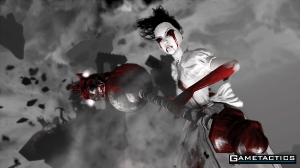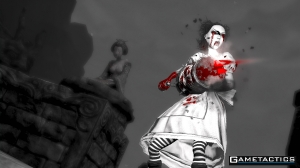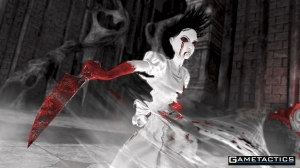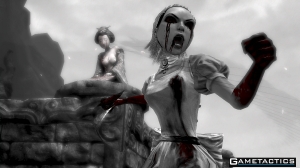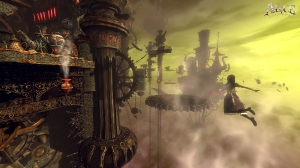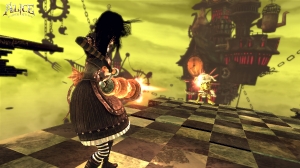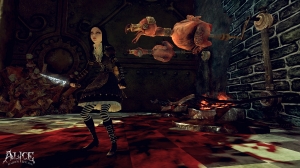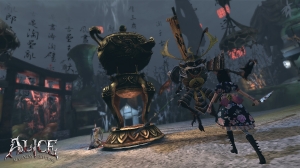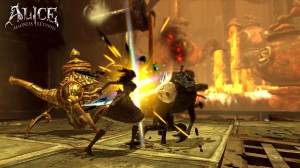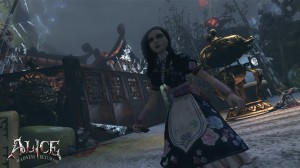 Alice: Madness Returns is a sequel to American McGee’s Alice from 2000. That title was one of the first pieces of art that started the dark Alice in Wonderland trend which culminated in the recent movie, not based on the game though. It garnered great reviews but the community looking back appears to be split on if it was just good or better. American McGee has had a good career early on, working on the Doom, Hexen, and Quake franchises. The first title he threw his name on was American McGee’s Alice but since then the reviews have not been so good. The developer of Alice: Madness Returns is Spicy Horse and considering the studios just started in 2007, they’re just starting to get their feet wet. Can American McGee and a relatively new studio match the quality of the first title or are they doomed to their own darkness?
Alice: Madness Returns is a sequel to American McGee’s Alice from 2000. That title was one of the first pieces of art that started the dark Alice in Wonderland trend which culminated in the recent movie, not based on the game though. It garnered great reviews but the community looking back appears to be split on if it was just good or better. American McGee has had a good career early on, working on the Doom, Hexen, and Quake franchises. The first title he threw his name on was American McGee’s Alice but since then the reviews have not been so good. The developer of Alice: Madness Returns is Spicy Horse and considering the studios just started in 2007, they’re just starting to get their feet wet. Can American McGee and a relatively new studio match the quality of the first title or are they doomed to their own darkness?
The story takes place after American McGee’s Alice. You’re now a teenager and still in the orphanage. The event that affected your family at the beginning stick racks your brain and has started to warp the beauty of Wonderland. The madness that affects yourself is inexplicitly linked to what is happening in your dream world. As you traverse the dreamscape and help your friends in Wonderland, you will start unlocking the secrets trapped in your mind. The story is dark. The world is dark. This is American McGee’s style when it comes to this title. The story is okay, nothing special. When considering who this title is intended for, I struggle. The dark story and world may be much for little kids and platformers don’t do that well for adults but the game is rated M. It has sexual themes. The bigger issue is that the gameplay works to the detriment of the world and story.
Alice: Madness Returns is at its heart a platformer with a healthy dosage of combat. The platforming feels good. Like its predecessor, Wonderland is a dangerous place and requires a lot of jumping to traverse crevasses and get to where you need to go. In this title, Alice is equipped with a triple jump and has the ability to flow via puffing up her dress ala a parachute. All in all it is quite standard fare. The one unique aspect of it is your ability to shrink yourself and as a byproduct, see hidden passageways and platforms. Unfortunately, how this is all structured leaves a bit to be desired. For the most part you will be moving from point A to B, shooting or pressing a button and moving to the next area. There are some jumping puzzles but not very frequent, most is find the button to move the platform so you can jump to the next area. Death is easily answered with a respawn right next to where you died meaning frustrations about jumping are rare. Despite the great art style, it makes the world feel a bit more like going through basic game design mechanics than navigating a living world. It feels good, just wish there was more diversity in how you overcome challenges in your path.
Combat is an element of platformers that can be a little rocky. In this title, the system works quite elegantly. Each weapon you acquire is powerful and useful. Collecting teeth along your travels allows you to upgrade them to be more powerful. In battle, you’ll be relying on each and everyone to vanquish your elements. A swift dodge move keeps you quickly traversing the landscape as you fight. Each weapon has its niche. Sometimes you’ll have to break guards or shields before you can hurt them. Sometimes using a combo of ranged weapons and close quarter weapons is the right recipe. But that becomes the problem, other than the cannon fodder, each enemy has a recipe. Sometimes you can get to the end using slightly different methods but there is not much room for interpretation. In the beginning, this is great. Each enemy is a puzzle and when pitted against several different types, you have to manage the crowd, isolate the biggest threats, and then tackle them with surgical precision. At the later stages, it feels like going through the motions over and over, repetitive. The other drawback is the lock-on camera. You lose a lot of situational awareness and it doesn’t benefit your view much. Most of the time, you just kill everything and if you have to, lock on. Death in combat is dealt with differently than with platforming. You’re thrown back much further to an autosave point making you relive the last 5-10 minutes. It doesn’t sound bad but it feels like you’re punished much more than you need to be considering with how nice the platforming death is dealt with. The combat system is swift, agile and quick. Managing multiple enemies at once and instantly switching between your weapons feels great. At the end though, it can get repetitive.
The aspect that excelled in McGee’s vision of Alice is the look. Some areas can be bright and vibrant and others dark and menacing. That tradition has continued here. Some areas look absolutely fantastic. At one moment you can be in the sky in a world made out of cards and others you’ll be dark imaginative pits in dirt. One of the things that the Unreal engine has struggled with this generation is with hair. It’s one of the reasons some Japanese developers have gone with other engines or even their own creation. But here, they’ve solved it. Space marine baldness is not here. Alice’s hair flows in the wind very nicely and there aren’t any artifacts or aliasing. It looks nice. That’s one of the things that stand out, the creativity used, the sculpting of a dark Wonderland. It does not meet the quality of the first title as gameplay elements make it feel repetitive at times but the look is solid. It shows that art can lift a game above any technical achievements.
The world sounds decent in its own right, though like the graphics, will feel degraded because of the game mechanics rather than anything else. Jumping, combat, and everything in-between sounds just as you would expect. The characters are fully voiced and sound good but are not as funny or as frequent as the original game. The music, while quite forgettable, tends to enhance the atmosphere like it should. When the action gets furious, the music will pick up. Unfortunately, sometimes these themes last longer than they should. Nothing particularly amazing is happening on screen, just simple platforming and your ears will continue to get pounded by grand upbeat action piece music. Kind of kills the mood when you have to sit back and ask why this music is playing. But overall, the sound design is good. It gets the job done. It’s exactly what you expect and not much more.
Alice: Madness Returns is a delightful diversion from the norm. The platforming is entertaining and the combat is great. While it outstays its welcome in the game mechanic department, the visuals never let up. It proves that art outshines the greatest graphical technique. The sound design may be forgettable, but undoubtedly adds to the experience. And when you buy the game new, you get the complete American McGee’s Alice as a bonus. Two games for the price of one. They aren’t the most stellar titles but the value proposition is a strong one. Alice is worth it if you’re a fan of platformers or just wish to have a diversion from the norm.
Gameplay
Graphics
Sound
Overall
Click here to buy Alice: Madness Returns Online from EBGames.com

Click here to buy Alice: Madness Returns Used or New online for a great price from EBgames.com

